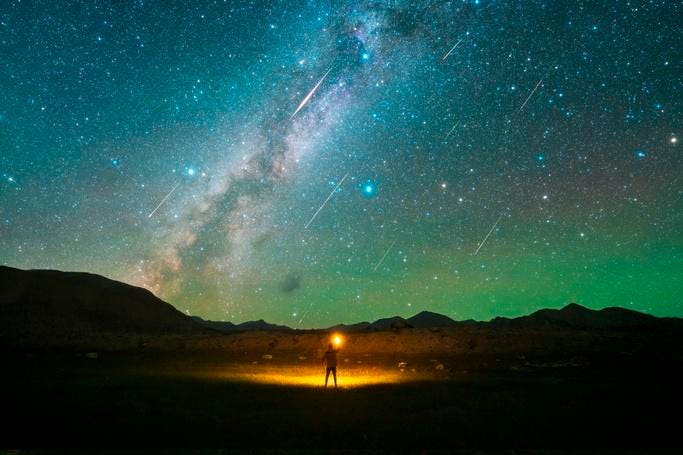A man watches the Perseid meteor shower on the Pamir Plateau on August 13, 2021 in Xinjiang Uygur … [+]
June through September in the northern hemisphere can be a tricky time for stargazers, particularly those in the higher northern latitudes where it doesn’t get dark until late—and not for long.
So as well as a few late-night sights—such as the arc of the Milky Way and the appearance of the three famous stars that make-up the Summer Triangle—look out for these must-see full Moons, planetary conjunctions and meteor showers for summer.
It may rarely get completely dark, but even in twilight skies there will be more than enough to keep your eyes on the sky.
Here’s everything you need to know about stargazing in summer 2023 in the northern hemisphere:
1. A brilliant full ‘Buck Supermoon’ rises
July 3, 2023
The first full Moon of summer in the northern hemisphere, the “Buck Moon” will also be the first of four supermoons in 2023, albeit the farthest from Earth at 361,934 km. Best viewed at moonrise on Sunday, July 2, 2023 just before it turns 100% full.
2. Venus swaps from ‘Evening Star’ to ‘Morning Star’
July 9 and September 18, 2023
As seen from Earth, the position of Venus will change dramatically this summer. On July 9 it will be at its brilliant best as the bright “Evening Star” close to the horizon just before dipping into the Sun’s glare to re-emerge as a brilliant “Morning Star” in the pre-dawn skies, peaking in brightness on September 18.
Get ready for a supermon!
3. See the spectacular ‘Sturgeon Supermoon’
August 1, 2023
The second full Moon of summer in the northern hemisphere, the “Sturgeon Moon” is a supermoon, turning full while 357,530 km from Earth. That’s only slightly farther away than next month’s closest full Moon, so the “Sturgeon Moon” will be very big and very bright. It will look its best at moonrise on two successive evenings, Monday, July 31 and Tuesday, August 1.
4. A perfect Perseid meteor shower
August 12/13, 2023
Get ready for 100 “shooting stars” each hour in a dark sky—and mark your calendars for a camping expedition! After a few years under moonlit skies the northern hemisphere’s most popular meteor shower’s peak occurs in 2023 when the moon has set. Known for bright and fast-moving meteors (and frequent “fireballs”), the Perseids are caused by comet Swift-Tuttle, which orbits the Sun approximately every 133 years. The Perseids are named after the constellation Perseus, from which the meteors appear to radiate.
5. Saturn at opposition
August 27, 2023
Saturn will reach its bright opposition on August 27, 2023.
The ringed planet will shine at its brightest—and shine all night—on this date. Why? Earth will be placed between the Sun and Saturn, with the latter thus 100%-lit from our point of view, rising in the east at sunset and setting in the west at sunrise. However, our view of the gas giant’s rings are narrowing slightly, and will continue to do so through 2025, when they begin to open-up again. Either way, tonight—and, practically speaking, a few weeks either side—is a fabulous time to train a small telescope on the ringed planet in the constellation Aquarius.
6. See a ‘Super Blue Moon’
August 30 and 31, 2023
The third and final full Moon of summer in the northern hemisphere will be a “Super Blue Moon” because it’s the second full moon in a calendar month, something that is bound to happen every few years because the Moon takes 29 days to orbit the Earth. It’s also the closest full Moon to Earth—so the year’s best “supermoon.” It will turn full while 357,344 km from Earth and be the biggest, brightest full Moon of the year. It will look its best at moonrise on two successive evenings, Wednesday, August 30 and Thursday, August 31.
7. Jupiter, the Moon and the ‘Seven Sisters’ align
September 5, 2023
As if the reappearance in the night sky of the sparkling “Seven Sisters” stars—also called the Pleiades—wasn’t enough, late tonight in the northeastern night sky sees it between a bright planet Jupiter and a 57%-lit crescent Moon in the constellation Taurus. It will be a spectacular sight for the naked eyes—but even better through binoculars.
Times and dates given apply to mid-northern latitudes. For the most accurate location-specific information consult online planetariums like Stellarium and The Sky Live. Check planet-rise/planet-set, sunrise/sunset and moonrise/moonset times for where you are.
Wishing you clear skies and wide eyes.
Discover more from Today Headline
Subscribe to get the latest posts to your email.












